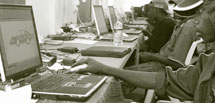Current Projects
Report on the Ramingining Computer Project, January 2007
I came back to Ramingining in June 2006 and one of the first things I did was a survey of the computers already in the town. To my surprise I found 130. I confess I had expected to find about 50.
Of these 130, 110 were functioning at the time but outside of the school only 12 of them were being used in any appreciable way by Yolngu in work places. And only one of them was located as a potentially ‘public access’ computer – in the Women’s Centre. A great place but not one where everyone feels comfortable to just ‘rock up’ – especially many men and boys.
Over the next few months I spent a lot of time in the Women’s Centre, and also the Council office, and some time doing ‘introduction to computers’ tutoring for 3 of the staff at the Homelands Resource Centre. In all these settings, I was able to watch what the title of my reseach implies, ‘the social life of the computer’. How does it live here? Who does it hang out with most? Why do people approach computers? Who do they come with and what do they say as they approach them? Are the computers friendly in return? Do people go away happy with the encounter and come back?
This is an early and ongoing story. Certainly a few themes are emerging. There are big and growing demands for access to computers for banking and for what we call ‘MP3 djäma’ – charging MP3 players and downloading music onto them. It is not yet clear how widespread, from across the community, and evenly, this demand is flowing .. but the evidence so far suggests that it is not even; that it is concentrated in families.
And given the dearth of public access, people are thrown back onto asking for access to work, school and privately owned computers. That is, mostly Yolngu having to ask balanda for this access; the sort of dependency which accompanied the arrival of landline phones before mobiles.
But throughout these months the most strident actors in this story have been all those people, processes and bits which generally remain hidden, or at least play only supporting roles, in most of the towns and cities of Australia. The IT shops, the technicians, the people with that vital piece of information (‘I usually fix that problem by just turning the power on the router off and on again.’), the missing leads, the inactive phone lines, the forgotten pin numbers. All the bits of the vast network we all know is ‘behind’ our computers but which remains marginal or unthought-of until a piece slips, and then it’s just a phone call (in our native tongue) or a trip back to the shop, to restore it. There’s no computer shop out here, no resident technicians. There are some cardboard boxes full of spare leads and other assorted bits. There are phone numbers for those technicians we have tried before and who have proved invaluable. And there are those 110 functioning computers. But nearly all of them are in places only balandas have keys to. So there is another unexpected actor in this story, the keys to buildings. Especially the key to the old library, which had several computers back in 2004, but which has been closed for about 2 years, pending the rebuilding of the Council building, which is falling down.
I have been dependent on Actor Network Theory (Latour 2005) to teach me how to follow these actors, and how to avoid the ‘ANT crime’ of resorting to sorting exercises with category labels like ‘technical’ and ‘social’ factors. But this is all part of my ongoing study.
Meanwhile, it isn’t possible to do long term research in a remote community like this, (only accessible by air and sea in the wet season, and currently without its own regular air service) without the community’s consent and without accommodation. After four years teaching here, the community readily gave its consent, but housing became an issue. Only public servants (teachers, nurses, CEOs, accountants, builders, mechanics, etc) get government housing, and there are no houses to rent. And there is a huge waiting list for Yolngu families to maintain or extend their houses.
So for the first 5 months back here as a student I lived in 5 different houses, as ‘the Ramingining cockroach’, scuttling from empty house to empty house, as they were temporarily vacant or folks were on holiday. I then undertook a massive exercise with the Council’s support, to create my own accommodation in a caravan. All the actors involved in remote housing stories then emerged from the wings: barges, forklift trucks, back hoes, meter boxes, electricians (which live somewhere else), water, pipes, toilets, buckets with lids. It took three months.
This week, at the end of January 2007, I have just moved into this caravan under a large tin roof shelter. I am now awaiting the installation of a satellite dish, under the DCITA sponsored program Broadband Connect. That will mean one more internet access point for the community. The fact that it will be under a tin roof beside a caravan is a fitting comment on this project and a great opportunity for watching for new actors in this story.
Just up ahead, I hope to be involved in the reopening of the library, working with both the Council and NTLIS, who have been waiting in the wings eager to support this kind of project. That will mean more public access to computers and the internet, and more chapters in this story.
My email address is anthea.nicholls@cdu.edu.au and
I’d love to talk with fellow travellor researchers.
Latour, B. (2005). Reassembling the Social: An Introduction to Actor-Network-Theory. Oxford, Oxford University press.
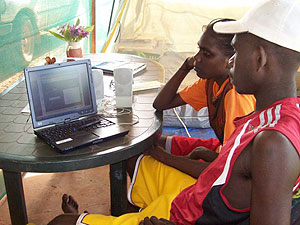
Shannon and Elijah, hunting for music
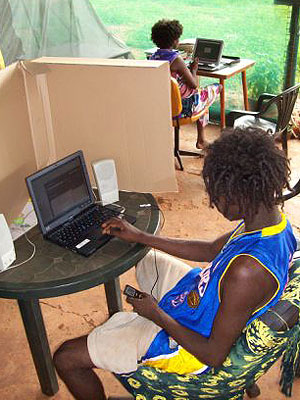
Elijah is searching the net for music, using an improvised light shield while Joanne plays cards. Both are tablet computers from CDU
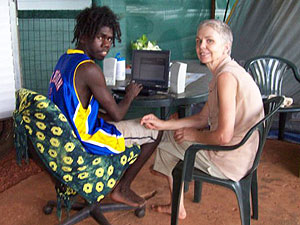
Elijah and Anthea
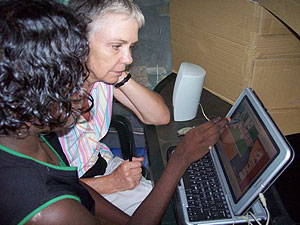
Playing a game of cards while iNet music plays in the background. (The girl is from Maningrida and very articulate and computer savvy. She says they have 6 computers in her classroom and they can use them when they finish their work, and for electives.)

